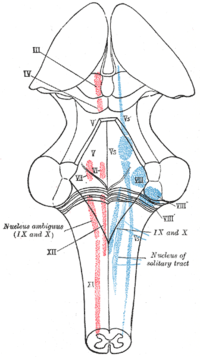
Photo from wikipedia
A total of 668 single units were recorded in the mouse periaqueductal gray (PAG) and adjacent deep mesencephalic nucleus (DpMe) to determine their role in the switching of sleep–wake states,… Click to show full abstract
A total of 668 single units were recorded in the mouse periaqueductal gray (PAG) and adjacent deep mesencephalic nucleus (DpMe) to determine their role in the switching of sleep–wake states, that is, wakefulness (W), slow‐wave sleep (SWS) and paradoxical (or rapid eye movement) sleep (PS) in general, and, in particular, to determine whether PS‐on and PS‐off neurons involved in PS state switching are present in these structures and to identify neuronal substrates for the SWS‐PS switching mediated by DpMe neurons. Both structures were found to contain similar percentages of W/PS‐active neurons, which discharge at a higher rate during W and PS than during SWS, while W‐active neurons, which discharge maximally during W, were found mainly in the PAG. Both also contained similar percentages of SWS/PS‐active neurons, which discharge at higher rates during SWS and PS than during W, and PS‐active neurons, which discharge maximally during PS, while SWS‐active neurons, which discharge maximally during SWS, were found almost exclusively in the PAG. Both structures contained virtually no PS‐on or PS‐off neurons, which, respectively, discharge or cease firing selectively and tonically just prior to, and during, PS. Unlike the PAG, the DpMe contained many SWS/PS‐on neurons, which discharge selectively at high rates during SWS and PS, but show a decrease in discharge rate at the transition from SWS to PS. Analysis of discharge profiles and trends in spike activity at the state transitions strongly suggests that PAG and DpMe neurons play an important role in the W‐SWS, SWS‐PS and/or PS‐W switches.
Journal Title: European Journal of Neuroscience
Year Published: 2018
Link to full text (if available)
Share on Social Media: Sign Up to like & get
recommendations!